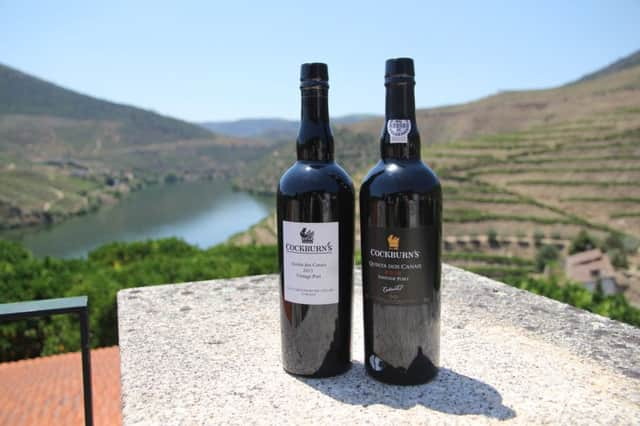Wine: A diamond Portugueser


This was the perfect time to utter those memorable words from a TV ad that ran every Christmas a few decades ago “Did anyone bring the petits fours?” It was a cracker of a line, but sadly my travelling companions were still in their infancy when those ads were aired. So they didn’t remember the Titanic-like set, where the survivors were in a lifeboat and the only thing they had managed to save was a bottle of Cockburn’s port. “It is Co-burns, not Cock-burns,” intoned the voice-over, while the well-dressed lady delivered the punch line that I thought would set the whole table laughing. I was wrong, but I covered my embarrassment by pouring myself a generous glass of port.
The reason I was invited to sit at that polished table was to catch up on Cockburn’s and its ports which have gone through quite a transformation since those glory days of TV advertising. Cockburn’s was established in 1815, just after the end of the Peninsular War, by Robert Cockburn of Edinburgh, to ensure a supply of quality port for their wine business. Over the generations the company acquired vineyards in some of the best areas of the Douro. In a drive to improve quality, one of the family established an experimental vineyard at Quinta do Tua in the 1930s, to investigate the various grape varieties used in the Douro. That was possibly the moment when Touriga Nacional was saved. Low yielding, many farmers had ripped out this variety, but Cockburn’s recognised its contribution to quality and kept it.
Advertisement
Hide AdAdvertisement
Hide AdBut in the 1960s, after two World Wars and in the face of falling sales, the descendants of Robert Cockburn sold the company to their friends, Harvey’s of Bristol. Harvey’s were subsequently bought out by a multinational, and that is when Cockburn’s Special Reserve was invented. This was the “partner” to Harvey’s Bristol Cream and it became the brand that everyone drank at Christmas. And I mean everyone. This was the world’s best-selling port.
But good times don’t last forever and after the company was bought and sold again, the focus on the brand was lost and sales together with quality dwindled. No multinational gives up its former big brands easily, so it took five years for the Symington family, owners of Grahams, Dows, Warre’s and Quinta do Vesuvio ports, to negotiate to buy, first the vineyards and lodges and then eventually, the Cockburn’s brand. This was no small purchase. The Cockburn lodge is the largest in Vila Nova de Gaia. Cavernous, lofty and stocked with huge ageing vats as well and row upon row of pipes of port, gently ageing in the cool, half-lit lodge, this is a vast amount of stock to buy. And there are the vineyards and the Quinta dos Canais, which, because it was last owned by an American company, is the only Quinta in the Douro with an efficient air-conditioning system.
Now the Symingtons are concentrating their efforts on bringing Cockburn’s back to its former glory. They have already changed the blend for Special Reserve, making it deeper, with rounder, smoother flavours and they have switched off the chilling system that stripped out much of the flavour in the wine. It is an aged Ruby port, matured for three to five years and it is full of dark cherry and plum flavours, not too sweet, that goes well with cheese, chocolate and, should you remember the ad, petits fours too. Cockburn’s Special Reserve is widely available at around £12.
They have also cast a critical eye over the winery that was installed by one of the previous corporate owners and found it lacking. No doubt it cost a lot of money at the time, it uses the “movimosto” process which sprays fermenting juice over the somewhat deep lagars. Now the plan is to improve winemaking, probably using some of the mechanical lagars that reproduce the action of traditional foot treading. This method produces excellent ports, with soft tannins.
Advertisement
Hide AdAdvertisement
Hide AdThey are also taking Cockburn’s back into the vintage port business. Cockburn’s 2011 (Harrogate Fine Wine, £49.99) is a fabulous wine, with layers of dark plum and damson, with touches of tobacco and spice. It is drinkable now, but this is one that will mature elegantly for several years. Quinta dos Canais is also now released as a single Quinta wine. I tasted vintages from 2010, 2013 and 2014, all starting to show ripe, linear fruit with a streak of peppery spice.
Bizarrely, the Symingtons discovered a stash of the renowned 1977 vintage Cockburn’s port in the lodge. This was certainly not part of the multi-national company’s plan, but someone made it, bottled it and secured all the right paperwork for it, and 1,340 bottles will be released this autumn.
But there is particular excitement about the experimental vineyard. The Symington family are continuing that work with the grape varieties of the Douro. They are isolating the best clones, working out the best rootstocks for each soil type and they are dividing vineyards into small plots to work out exactly what does best and where.
It is the kind of work that Robert Cockburn would be proud of. Two hundred years after he established his company, his name is still on the bottle, and once again, the quality of the wine is paramount.
Advertisement
Hide AdAdvertisement
Hide AdHe might also be pleased that in this anniversary year the Cockburn’s boat won the Barco Rabelo race in Porto. Robert would have travelled on these traditional boats that brought wine from the vineyards to the lodges on a precarious journey of rapids and boulders. Manned by Symington employees, the Cockburn’s boat surged ahead of the others in the race. Perhaps Robert helped blow wind into the sails?